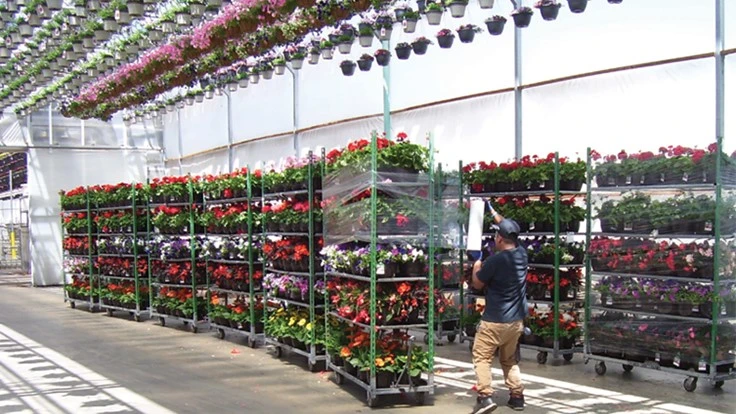

Minimum wages are increasing. In 2018, 20 states and Washington, D.C., increased minimum wages and again in 2019, 20 states and Washington, D.C., have increased minimum wages as of this publishing. With labor being about half the cost of production, growers should pay particular attention to where labor input can be reduced. Here are a few tips that may help.
Pallet handling equipment is necessary. Most of the materials that are delivered to greenhouses come on pallets. This increases efficiency in handling and reduces breakage. Pallet trucks, lift trucks and fork lifts are designed for this purpose. A tailgate height dock may be necessary with some equipment. Consider the purchase of used equipment to reduce the initial cost.
Design your facility for efficient materials and plant movement. Reduce unnecessary transport, combine different tasks into one transport if possible and transport through the shortest route. In developing a layout, decide whether the receiving and shipping should be separate or in the same location.
Carts are the backbone in the greenhouse industry for moving plants. All sizes of greenhouse operations can benefit from carts. They increase labor efficiency by allowing one person to move more material at one time than they could when carried by hand. They also reduce fatigue. Select a cart that can be handled by one person, has variable shelf spacing and can be towed. The 22-inch-wide cart is convenient as it holds the standard flat and fits into narrow aisles in the greenhouse.
With labor being about half the cost of production, growers should pay particular attention to where labor input can be reduced.
Provide easy paved access. Provide concrete walkways to handle the volume of materials moved. Aisles should be paved and at least 8 inches wide for equipment movement. Doors should be wide enough for cart or forklift operation. Elevation differences can be connected by ramps with a slope of 1:12 for easy movement.
Add a hydraulic tailgate or pony forklift to delivery trucks to speed loading and unloading. Side entry trucks and trailers allow easy access to pallets.
Mechanize jobs that are repetitive, tedious or time-consuming. Frequently, these are the easiest to mechanize and result in a significant reduction in labor. Examples are watering, flat filling, transplanting and plant spacing. Manual and automated equipment is available to fit all sizes of operations.

Select equipment that will pace workers. Conveyor belts work well for potting, transplanting and packaging, providing uniformity and consistency. A variable speed motor adjusts the belt speed for different operations.
Reduce the amount of walking that employees have to do. Walking adds considerable time to the cost of plants. An average time to pick up or set down a flat of plants is 1.5 seconds. Carrying or walking can be figured at 4 feet/second. At a $12/hr labor rate, making a round trip 10 inches away to place a flat of plants on a bench adds 3 cents to its cost. Walking to the far end of a 100-inch greenhouse costs $0.18.
Purchase a plant inventory control system. Available in “Mom and Pop operation” models to multi-acre size, they can provide updated information on number and variety of plants, size of plant and container, greenhouse or bay location and price. Uploaded to a handheld scanner or computer, this information can then be used to maintain inventory, sales and billing records. It also helps to determine seasonal production and customer needs.
Standardize your operations. Keep the number and types of containers that are used to a minimum to reduce inventory and the time needed to make changes to equipment. Where possible ship in standard units such as carts or pallets. This simplifies loading and invoicing.

Explore the September 2019 Issue
Check out more from this issue and find your next story to read.
Latest from Greenhouse Management
- Happy holidays from the GIE Media Horticulture Group!
- North Carolina Nursery & Landscape Association announces new executive vice president
- Plant Development Services, Inc. unveils plant varieties debuting in 2025
- Promo kit available to celebrate first National Wave Day on May 3
- Applications now open for American Floral Endowment graduate scholarships
- Endless Summer Hydrangeas celebrates 20 years with community plantings
- Invest in silver
- Garden Center magazine announces dates for 2025 Garden Center Conference & Expo





